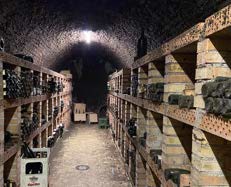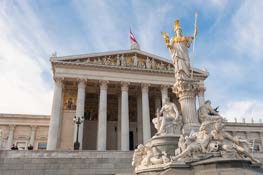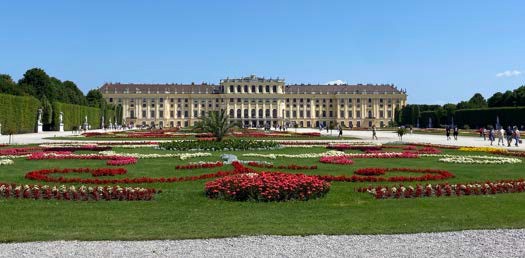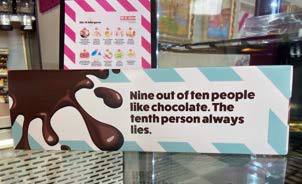Overview
Vienna is the largest city in Austria. It’s population of 2 million is almost back to the pre WWI levels. It’s a wealthy, well run, safe city, home to many international organizations and corporations. The weather is considered a continental pannonian climate. Pannonia refers to the Roman province that was made up of Hungary and Eastern Austria. There is little rain, summers are hot and winters are only moderately cold.

View over the Volksgarten, Austrian Parliament is on the right
Typical of a large city, Vienna is expensive with perfunctory service. A cappuccino can cost 6 euros while white wine, 1/8 liter, is 5 euros. Trains, streetcars and buses are packed with locals and tourists scurrying to their next destination. 42% of Viennese are foreign born, while 33% are foreign nationals. The largest emigrant groups are Serbs and Turks. Erdogan, Turkey’s prime minister, campaigned in both Austria and Germany prior to the most recent election in Turkey. Erdogan also
pays Turkish women living in Vienna a monthly stipend if they wear a hijab, a typical Muslim headscarf.
A coalition government of the OVP (moderate right wing) and the Greens is currently in power. The OVP plans to decrease illegal immigration and “political Islam”. This term refers to any Islamist movement that strives to restructure society according to religious ideals that contradict democratic

Austrian Sphinx
principles. However, a recently published map indicating the locations of 600 mosques has resulted in severe international criticism and a backlash within Austria. Vienna is 13% Muslim, similar to the Austrian percentage.
Vienna was the power center of the Holy Roman Empire and the Hapsburgs ruled the empire. Rudolph I used fake news and forged documents to trace his ancestry to the Romans and ultimately to Hercules. His lineage, combined with political maneuvering and opportune royal marriages cemented their dynasty. Early in their reign they were genetically lucky, frequently out living many of their rivals. The Hapsburgs would rule by divine right for more than 600 years. The empire had ever evolving boundaries. The Austrian Empire included possessions in South America, North America, Africa, Indonesia and for a brief time after before the Boxer revolution, a province on mainland China.

However, marriages which brought power and territory during the beginning of their reign would work to destabilize the empire after 1500. The bloodline was pure so there were frequent marriages between first cousins and uncles marrying nieces. The nobility was full of genetically pure monarchs with physical disabilities and mental incapacity. This was best illustrated in the Spanish House of Hapsburg, where kings and queens went mad and infant mortality was over 50%.
The Inner Stadt

St. Stephens Cathedral – roof replaced after WWII
Vienna was a fortified city. Thick walls encircled the old town and we’re consequential in holding off the Ottoman Turks in 1529 and 1683. In the 19th century the walls were taken down to expand and beautify the city. The Ringstraße is a grand boulevard that showcases many government buildings and a magnificent museum quarter.

Within the circle are impeccably maintained churches in gothic and baroque style, the Hofburg complex which includes the Spanish riding school and cafes. The home of the Lippizaner stallions has a plaque dedicated to General George Patton. In the final weeks of WWII, Patton provided the resources to rescue the stallions from Czechoslovakia. The horses were in danger of becoming rations for the advancing Red Army.
Also in the Inner Stadt is Café Central, a historic coffee house where the Austrian literati met. Leon Trotsky and Tito platted chess at the café in the early 1900’s. The food is excellent. The vaulted ceilings, linen covered tables and regal color scheme lends a historic ambiance to the café.
Wachau Valley
I took a day trip out of Vienna to one of Austria’s premier wine regions, the Wachau Valley. Austria produces wonderful white wines. The wineries are typically small scale ventures. Harold, our host, had a very welcoming disposition. He loves wine and loves being a vintner.


Between wine tastings, I had a hike in Durnstein and explored the castle ruins.
 Richard the Lionhearted was held at Castle Durnstein on the Danube in 1192. He was originally imprisoned in Durnstein before being handed over to Henry VI, the Holy Roman Emperor. The ransom was set at 100,000 pounds of silver. His mother, Eleanor of Aquitaine raised the funds by aggressive taxing and expropriating church silver and gold. Richard’s imprisonment created strange bedfellows as his brother John, teamed up with King Phillip of France and offered the emperor 80,000 pounds of silver to keep Richard locked up. Richard was released in February 1194 and promptly went to war with Phillip of France.
Richard the Lionhearted was held at Castle Durnstein on the Danube in 1192. He was originally imprisoned in Durnstein before being handed over to Henry VI, the Holy Roman Emperor. The ransom was set at 100,000 pounds of silver. His mother, Eleanor of Aquitaine raised the funds by aggressive taxing and expropriating church silver and gold. Richard’s imprisonment created strange bedfellows as his brother John, teamed up with King Phillip of France and offered the emperor 80,000 pounds of silver to keep Richard locked up. Richard was released in February 1194 and promptly went to war with Phillip of France.

Melk Abbey
After a lunch along the river and an afternoon wine tasting, I cruised on the Danube to the Melk Abbey. This abbey, established in 1089 and rebuilt in the baroque style in the early 1700’s, is famous for its library and frescos. Despite endless European wars, the abbey and its collection of medieval manuscripts has survived.
Outside the Ringstraße

Austrian Parliament
In 1857, Emperor Franz Joseph I of Austria issued a decree ordering the demolition of the city walls and moats. In his decree, he laid out the exact size of the boulevard, as well as the geographical positions and functions of the new buildings. The Ringstraße and the planned buildings were intended to be a showcase for the grandeur and glory of the Habsburg Empire.
The Austrian parliament was a sop to the populace. Civil unrest throughout Europe had
changed the balance of power between the ruling powers and the aristocracy. The Parliament built in a majestic Greek Revival style. It initially hosted a conclave of advisors to emperor Franz Josef. You can visit the Parliament, all you need is your passport. The educational level has multimedia displays, in English and German, highlighting the road to Austrian democracy from 1850 to the present. There are several presentations on the Anschluss, WWII and post war changes. Most tourist guides list the Palace the top site in. Marie Theresa had the palace constructed in the mid

View of Schönbrunn from the gardens
1600’s to rival Versailles. It’s elegant but too crowded with tourists to enjoy. The Belvedere Palace, was built by Prince Eugene of Savoy. The prince was from a noble French family. He wanted to serve Louis XIV, but due to his small stature in his mother’s prior indiscretions, he was refused. So, he traveled to the Hapsburg court, pledged allegiance to the Emperor and proceeded, over a sixty year military career, of defeating foreign powers, including the French, and winning territory for the Austrian Empire.
If you only have a brief time in Vienna, visit the Belvédère Complex. The upper palace has an extraordinary art collection. It’s well curated and the art seems appropriate for the rooms of the palace. It wasn’t crowded and the grounds and location outside the Ringstraße adds to the grandeur.

View from Upper Belvédère Palace over the garden, to the lower palace

The Naschmarkt is a nearly 1 mile long market that has existed since the 1600’s. It offers many Austrian products and delicacies. The vendors are friendly and happily give you samples of cheese, wild boar sausage, gourmet vinegars and smoked cashews.


Premium brewed vinegars
The Austrian Miracle

30% of Vienna was destroyed during WWII. In a key diplomatic maneuver, Austria, despite their early and enthusiastic cooperation with Germany, was able to claim they were the first victim of Hitler’s agression.
The City was occupied until 1955 by the French, English, Brits and Russians. The Austrian State treaty restored Austria’s independence. However, in order for the Soviets to agree to the treaty, Austria had to agree to never join NATO.
Austria rebuilt their infrastructure and economy quickly. Avoiding the cost of NATO helped. Gaining economic control back from the Soviets was also helpful. Austria benefitted from the Marshall plan and a well funded treasury. Much of their postwar wealth came from property and cash that had been extorted from individuals fleeing Austria after the Anschluss .
The money helped and the country’s commitment to rebuilding and restoring the city was impressive. There smaller, homogeneous population and efficient bureaucracy were key components in the rebirth of the city and the country.
Almost everything was restored. One exception is a monument across from the Opera House. A bomb destroyed the building and killed 800 people huddled in the cellar. A stark memorial to the dead and the horror of the war has replaced the building.
Potpourri

Friend’s apartment- very cosy


Marillenknödel – Sweet Apricot Dumplings
Ice coffee
Vienna has a lot to offer and in two weeks I only scratched the surface. There’s Opera six nights a week and Standing Places in the pit are only 30 euros. If the weather had been bad I would have spent more time in the museums. But the weather was generally glorious and a bit warm. I loved walking through several of Viennas districts. Each area had its own charm.


There are many horse carriages in the Inner Stadt. The ears are covered to keep out the flies
Cafe Central

A beautiful vegetable display in a chic market
Stairwell in Parliament



Knave of St. Stephens

Wachau Valley
